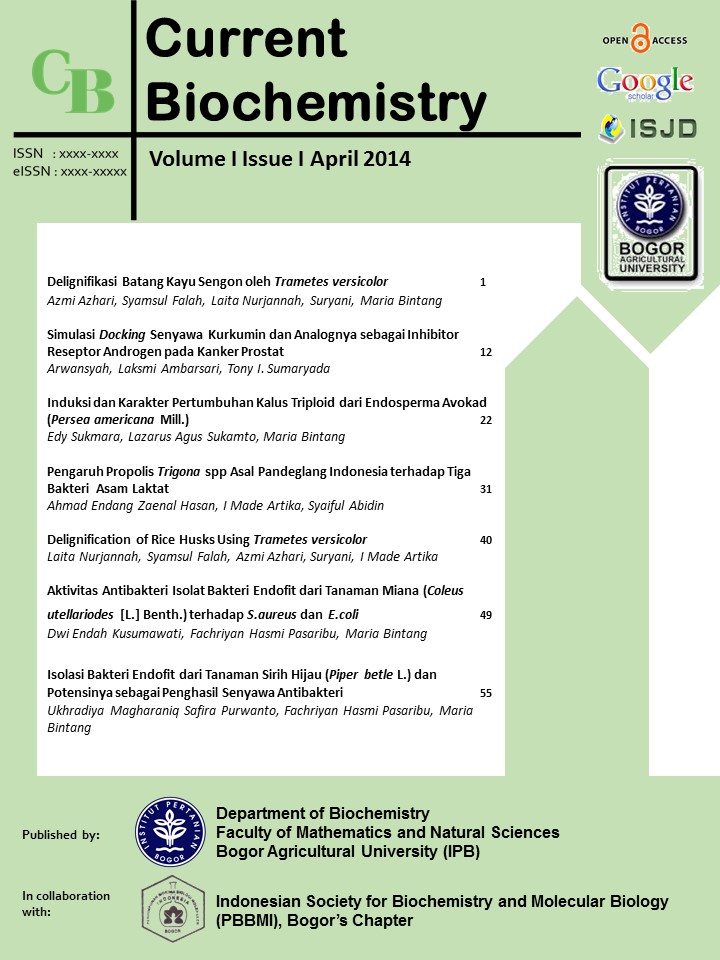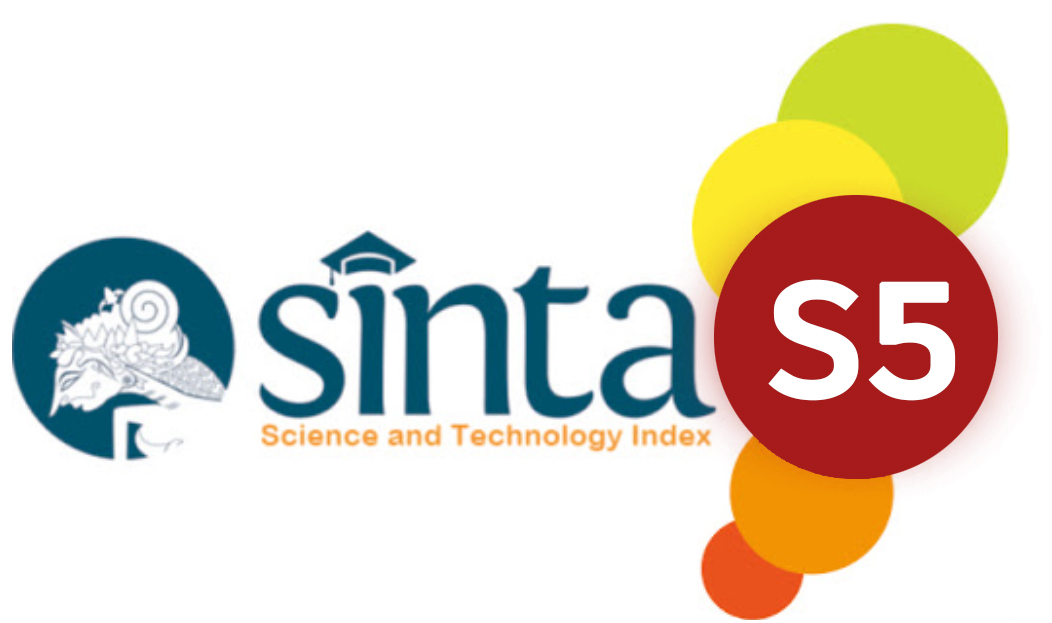<i>Trametes versicolor as Agent for Delignification of Rice Husks</i>
Abstract
Rice husks contains 33.71% w/w lignocelluloses, the most abundantly available raw material on the earth for the production of biofuels and other valuable products. It is comprised of the carbohydrate polymers, cellulose, hemicellulose, and an aromatic polymer, lignin. One of the methods for removing the lignin component of rice husks is by delignification using white-rot-fungi. The aim of the study was to carry out delignification of rice husks using white-rot-fungi. The white-rot-fungi used here were Trametes versicolor and Phanerochaete chrysosporium. The study consisted of a biomass and microbial preparation, chemical assay of the rice husk, ligninase enzyme tests, and delignification of rice husks. Results showed that T. versicolor and P. chrysosporium have ligninase enzyme. The precentage of lignin from the total biomass rice husks was 23.61% w/w, and following the delignification process by T. versicolor for 20 days, the remaining lignin was 16.20% w/w, making the percentage of rice husks lignin degraded as 7.41% w/w. The biodelignification process also decreased the percentage of holocellullose, cellulose, and other extracted substances, and accordingly this increased the percentage of hemicellulose. Based on the ability of T. versicolor to degrade lignin of the rice husk at room temperature (28 ºC) as mentioned above, it can be concluded that T. versicolor has potential to be used for delignification process.
References
Agustini L, Irianto RSB, Turjaman M, Santoso E. 2011. Isolates and enzymatic characterization of lignocellulolytic microbes collected from three types of national park ecosystems. Jurnal Penelitian Hutan dan Konservasi Alam 8: 197-210.
Akhtar M, Blanchette RA, Kirk TK. 1997. Fungal delignification and biomechanical pulping of wood. Adv in Biochem Engineering/Biotech 57: 159-195.
Anindyawati T. 2010. Potensi selulase dalam mendegradasi lignoselulosa limbah pertanian untuk pupuk organik. Berita Selulosa 45:70-77s.
Anita SH, Yanto DHY, Fatriasasi W. 2011. Lignin use of isolation from black liquor on the biopulping of Betung bamboo (Dendrocalamus asper) as selective media for white-rot fungi. Penelitian Hasil Hutan 29: 312-321.
[BSN] Badan Standardisasi Nasional (National Standardization Agency of Indonesia). 1989. SNI No. 1032, Test Method for Alcohol Benzene Extract Content in Pulp and Wood. Jakarta: Indonesia.
[BSN] Badan Standardisasi Nasional (National Standardization Agency of Indonesia). 2008. SNI No. 0492, Pulp and Wood, Test Method for Lignin Content - Klason Method. Jakarta: Indonesia.
[BSN] Badan Standardisasi Nasional (National Standardization Agency of Indonesia). 2009. SNI No. 0444, Test Methods Of Cellulose Alpha, Beta, and Gamma. Jakarta: Indonesia.
Browning BL. 1967. Methods of Wood Chemistry. Interscience Publ. Vol II. New York. p 393-396.
[Deptan RI] Basis Data Statistik Pertanian 2011. [Internet]. http://www.bps.go.id/tnmn_pgn.php (12 November 2013).
Cross CF, Bevan EJ. 1912. Researches on Cellulose III. London: Longmans Green.
Indonesian Center for Agricultural Postharvest Research and Development. 2001. Peluang Agribisnis Arang Sekam. Jakarta:BPPP. p 1-2.
Ismunadji M, Partohardjono S, Syam M, Widjono A. 1988. Padi. Bogor: Badan Penelitian dan Pengembangan Pertanian.
Howard RL, Abotsi E, Jansen van Rensburg EJ, Howard S. 2003. Lignocellullose biotechnology: issues of bioconversion and enzyme production. African J of Biotechnol 2:602-619.
Irawati D. 2006. The utilization of sawdust for ethanol production. [Thesis]. Bogor:Bogor Agricultural University.p 47-70.
[ICAPRD] Indonesian Center for Agricultural Postharvest Research and Development. 2001. Agribusiness opportunities husks. Jakarta: ICAPRD.
Lobos SM, Tello R, Polanco LF, Larrondo A, Manubens L, Salas, Vicuna R. 2001. Enzymology and molecular genetics of the ligninolytic system of the basidiomycete Ceriporiopsis subvermispora. Curr Sci 81: 992-997.
Loebis EH. Optimization of chemical and enzymatic hydrolysis of oil palm empty bunches to glucose for bioetanol production. [Thesis]. Bogor: Bogor Agricultural University. p 33.
Martina A, Yuli N, Sutisna M. 2002. Optimasi beberapa faktor fisik terhadap laju degradasi selulosa kayu albasia Paraserianthes falcataria (L) Nielsen dan karboksimetilselulosa (CMC) serta enzimatik oleh jamur. J Nat Ind 4: 156- 163.
Reid ID. 1985. Biological delignification of aspen wood by solid-state fermentation with the whiterot fungus Merulius tremellosus. Appl Environ Microbiol 50: 133-139.
Siswanto, Suharyanto, Fitria R. 2007. Production and characterization of laccase Omphalina sp. Menara Perkebunan 75 (2):106-115.
Stalpers JA. 1978. Identification of wood-inhabiting Aphyllophorales in pure culture. Centraalbureau Voor Schimmelcultures, Baarn. Studies in Mycology 16:1-248.
Sun Y, Cheng J. 2002. Hydrolysis of lignocellulosic materials for ethanol production: a review. Biores Tech 83: 1-11.
[S1] Statistics Indonesia. 2013. Food crops. [Internet] http://www.bps.go.id/tnmn_pgn.php (8 February 2014).
Tuomela M, Vikman M, Hatakka A, Itavaara M. 2000. Biodegradation of lignin in a compost environment: a review. Biores Tech 72: 169–183.
Yu HY, Zeng GM, Huang GH, Huang DL, Chen YN. 2005. Lignin degradation by Penicillium simplicissimum. Huanjing Kexue/Environm Sci 26: 167-171.
Zeng GM, Yu HY, Huang HL, Huang DL, Chen YN, Huang GH, Li JB. 2006. Laccase activities of soil inhabiting fungus Penicillium simplicissimum in relation to lignin degradation. W J Microbiol and Biotech 22: 317–324.













